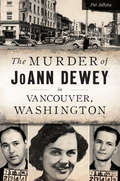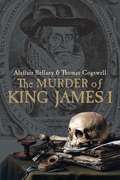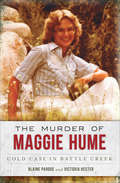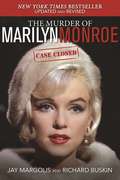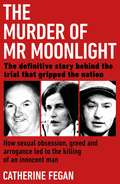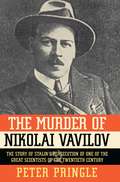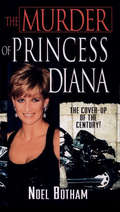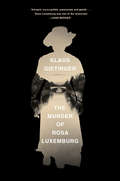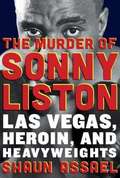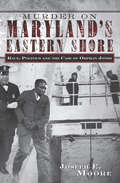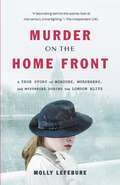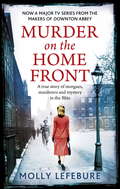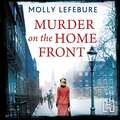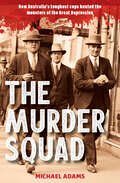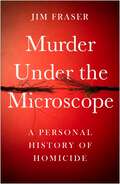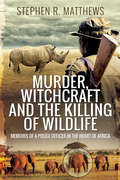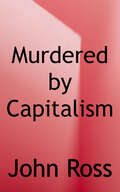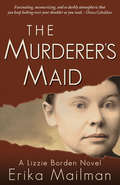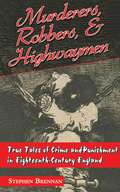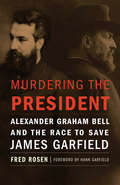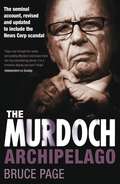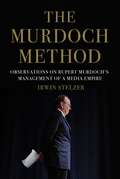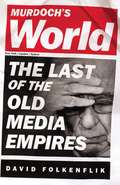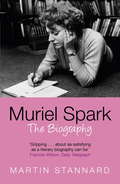- Table View
- List View
Murder of JoAnn Dewey in Vancouver, Washington, The (True Crime)
by Pat JollotaBefore midnight on March 19, 1950, several startled bystanders watched two men force a screaming young woman into a car and drive away from Saint Joseph's Hospital in Vancouver. One of them yelled out that she was his wife and was drunk. That was the last time anyone saw JoAnn Dewey alive. Her battered, naked body washed up on the banks of the Wind River seven days later. Suspicion quickly fell on two brothers, Turman and Utah Wilson, who fled town before police caught them in Sacramento. Their arrest and sensational trial captivated and divided the peaceful community. Author Pat Jollota uncovers the chilling details of this tragic story.
The Murder of King James I
by Alastair Bellany Thomas CogswellA year after the death of James I in 1625, a sensational pamphlet accused the Duke of Buckingham of murdering the king. It was an allegation that would haunt English politics for nearly forty years. In this exhaustively researched new book, two leading scholars of the era, Alastair Bellany and Thomas Cogswell, uncover the untold story of how a secret history of courtly poisoning shaped and reflected the political conflicts that would eventually plunge the British Isles into civil war and revolution. Illuminating many hitherto obscure aspects of early modern political culture, this eagerly anticipated work is both a fascinating story of political intrigue and a major exploration of the forces that destroyed the Stuart monarchy.
The Murder of Maggie Hume: Cold Case in Battle Creek (True Crime Ser.)
by Blaine Pardoe Victoria HesterOn August 16, 1982, an unidentified attacker brutalized and strangled Maggie Hume at her apartment in Battle Creek, Michigan. The daughter of a beloved local football coach, her seemingly senseless murder sparked intense scrutiny that lingers today. Award-winning author Blaine Pardoe and his daughter, Victoria Hester, crack open three decades of material on this mysterious tragedy, exposing dark secrets and political in-fighting that tore at the Battle Creek legal system for years. Compiled from documents, videos and interviews, this book presents the facts and clues of the case to the public for the first time.
The Murder of Marilyn Monroe: Case Closed
by Jay Margolis Richard BuskinA New York Times Best Seller!Since Marilyn Monroe died among suspicious circumstances on the night of August 4, 1962, there have been queries and theories, allegations and investigations, but no definitive evidence about precisely what happened and who was involved . . . until now. In The Murder of Marilyn Monroe: Case Closed, renowned MM expert Jay Margolis and New York Times bestselling author Richard Buskin finally lay to rest more than fifty years of wild speculation and misguided assertions by actually naming, for the first time, the screen goddess’s killer while utilizing the testimony of eye-witnesses to exactly what took place inside her house on Fifth Helena Drive in Los Angeles’ Brentwood neighborhood.Implicating Bobby Kennedy in the commission of Marilyn’s murder, this is the first book to name the LAPD officers who accompanied the US Attorney General to her home, provide details about how the Kennedys used bribes to silence one of the ambulance drivers, and specify how the subsequent cover-up was aided by a noted pathologist’s outrageous lies. This blockbuster volume blows the lid off the world’s most notorious and talked-about celebrity death, and in the process exposes not only the truth about an iconic star’s tragic final hours, but also how a legendary American politician used powerful resources to protect what many still perceive as his untarnished reputation.Skyhorse Publishing, as well as our Arcade imprint, are proud to publish a broad range of books for readers interested in history--books about World War II, the Third Reich, Hitler and his henchmen, the JFK assassination, conspiracies, the American Civil War, the American Revolution, gladiators, Vikings, ancient Rome, medieval times, the old West, and much more. While not every title we publish becomes a national bestseller, we are committed to books on subjects that are sometimes overlooked and to authors whose work might not otherwise find a home.
The Murder of Mr Moonlight: The tragic story of a young widow’s search for happiness and the killing of an innocent man
by Catherine FeganTHE NUMBER ONE BESTSELLER 'I was a very vulnerable young woman with three small children. I was lost ... Pat Quirke tried to come in and control everything'Bobby Ryan's disappearance in rural Tipperary in June 2011 mystified all who knew him. The truck-driver and part-time DJ (known as Mr Moonlight) was an easy-going fellow with no enemies. Or so everyone thought.When Ryan's body was found 22 months later on the farm of Mary Lowry, the wealthy young widow he had been seeing, it was clear that he had met a violent end.And the most likely person to have brought about that end? Pat Quirke, the man who had 'discovered' the body - Mary Lowry's brother-in-law, financial advisor, tenant and one-time lover.Following the longest running murder trial in Irish criminal history Quirke was convicted of murder in May 2019. Getting to that day had taken years of exhaustive work by gardaí. The Murder of Mr Moonlight is the definitive account of their investigation as well as the compelling story of how an innocent man paid the price for another man's obsessions.__________'Absolutely compulsive reading ... a page-turner' Eamon Dunphy'[An] excellent book that shows all the colours of the story that intrigued the nation' Irish Daily Mail 'Well-researched and highly readable ... Fegan proves her journalistic mettle, delivering forensic detail in accessible language ... Anyone who followed the trial will not be disappointed by Fegan's book' Business Post
The Murder of Nikolai Vavilov
by Peter PringleIn The Murder of Nikolai Vavilov, acclaimed journalist and author Peter Pringle recreates the extraordinary life and tragic end of one of the great scientists of the twentieth century. In a drama of love, revolution, and war that rivals Pasternak's Dr. Zhivago, Pringle tells the story of a young Russian scientist, Nikolai Vavilov, who had a dream of ending hunger and famine in the world. Vavilov's plan would use the emerging science of genetics to breed super plants that could grow anywhere, in any climate, in sandy deserts and freezing tundra, in drought and flood. He would launch botanical expeditions to find these vanishing genes, overlooked by early farmers ignorant of Mendel's laws of heredity. He called it a "mission for all humanity." To the leaders of the young Soviet state, Vavilov's dream fitted perfectly into their larger scheme for a socialist utopia. Lenin supported the adventurous Vavilov, a handsome and seductive young professor, as he became an Indiana Jones, hunting lost botanical treasures on five continents. In a former tsarist palace in what is now St. Petersburg, Vavilov built the world's first seed bank, a quarter of a million specimens, a magnificent living museum of plant diversity that was the envy of scientists everywhere and remains so today. But when Lenin died in 1924 and Stalin took over, Vavilov's dream turned into a nightmare. This son of science was from a bourgeois background, the class of society most despised and distrusted by the Bolsheviks. The new cadres of comrade scientists taunted and insulted him, and Stalin's dreaded secret police built up false charges of sabotage and espionage. Stalin's collectivization of farmland caused chaos in Soviet food production, and millions died in widespread famine. Vavilov's master plan for improving Soviet crops was designed to work over decades, not a few years, and he could not meet Stalin's impossible demands for immediate results. In Stalin's Terror of the 1930s, Russian geneticists were systematically repressed in favor of the peasant horticulturalist Trofim Lysenko, with his fraudulent claims and speculative theories. Vavilov was the most famous victim of this purge, which set back Russian biology by a generation and caused the country untold harm. He was sentenced to death, but unlike Galileo, he refused to recant his beliefs and, in the most cruel twist, this humanitarian pioneer scientist was starved to death in the gulag. Pringle uses newly opened Soviet archives, including Vavilov's secret police file, official correspondence, vivid expedition reports, previously unpublished family letters and diaries, and the reminiscences of eyewitnesses to bring us this intensely human story of a brilliant life cut short by anti-science demagogues, ideology, censorship, and political expedience.
The Murder Of Princess Diana
by Noel BothamAugust 31, 1997 Millions remember the tragic date when the world lost a princess and two boys lost their beloved mother. It was a freak accident--Diana, Dodi Fayed, and driver Henri Paul died fleeing aggressive paparazzi. . . or so officials led us to believe. But investigative journalist Noel Botham wasn't satisfied with the "official" story. The Murder of Princess Diana documents his intensive probe into what happened that fateful night in Paris. Finally, here is a book that dares to ask--and answer--questions such as:Was the blood sample supposedly taken from Henri Paul's body actually his blood?Why was the tunnel cleaned with detergent before forensic investigations could take place?Why was Diana's body partially embalmed before the post mortem?What were the connections between the driver of the Fiat Uno seen near the Mercedes and MI6? Was the man's subsequent fiery death really an accident?Did Diana's international campaign against landmines create a deadly conflict with the CIA? Culled from interviews with contacts from behind palace walls to within the halls of the Pentagon, this shocking expose blows the lid off cover-ups arranged in the highest echelons of power. Now, at long last, the secrets are revealed; the lies are exposed--and the truth about Diana's death is brought to light. Noel Botham has been a senior investigative reporter for News of the World and The People. During his thirty-five years as an internationally renowned journalist, he has been on numerous royal tours and has broken many major royal exclusives. He has been a crime and Parliamentary reporter as well as a distinguished war correspondent, covering conflicts in the Middle East, North Africa, Southeast Asia, Eastern Europe, and the Caribbean. He worked for the Evening Star and the Daily Herald and was chief investigative reporter for France Dimanche in Paris before becoming chief reporter of the Daily Sketch. His fifteen previous books include biographies of Rudolf Valentino and Princess Margaret.
The Murder of Rosa Luxemburg
by Klaus GietingerOn the tracks of the killers of Rosa LuxemburgThe cold-blooded murder of revolutionary icons Rosa Luxemburg and Karl Liebknecht in the pitched political battles of post-WWI Germany marks one of the greatest tragedies of the 20th century. No other political assassination inflamed popular passions and transformed Germany's political climate as that killing in the night of 15-16 January 1919 in front of the luxurious Hotel Eden. It not only cut short the lives of two of the country's most brilliant political leaders, but also inaugurated a series of further political assassinations designed to snuff out the revolutionary flame and, ultimately, pave the way for the ultra-reactionary forces that would take power in 1933. To commemorate the 100th anniversary of their untimely deaths, Klaus Gietinger has carefully reconstructed the events on that fateful night, digging deep into the archives to identify who exactly was responsible for the murder, and what forces in high-placed positions had a hand in facilitating it and protecting the culprits.
The Murder of Sonny Liston: Las Vegas, Heroin, and Heavyweights
by Shaun AssaelOn January 5, 1971, Sonny Liston was found dead in his home--of an apparent heroin overdose. But no one close to Liston believed that his death was accidental. Digging deep into a life that Liston tried hard to hide, investigative journalist Shaun Assael treats the boxer's death as a cold case. The result is a page-turning whodunit that evokes a glorious and grimy era of Las Vegas. Elvis Presley was playing two shows a night at the International. Howard Hughes was running his empire from the penthouse suite of the Desert Inn. And middle America was flocking to the Strip, transforming it from an exclusive playground for the mob to a mecca for corporate dollars. But the city was also rotting from within. Heroin was pouring over the border from Mexico, and the segregated Westside was on the cusp of a race war. The cops, brutally violent, were barely holding it together. Driving through town with the top of his pink Cadillac down, Sonny Liston was the one celebrity who was unafraid to bridge the two sides of Las Vegas. Cashing in on his fading notoriety in the casinos, he was dealing drugs, working for a crime syndicate, and trying to break into Hollywood--all with a boxer's faith that he could duck any threat, slip any punch. Heroin addiction was the only knockout blow he didn't see coming. The Murder of Sonny Liston takes a fresh look at the legendary boxer, the town he called home, and one of America's most enduring mysteries.From the Hardcover edition.
Murder on Maryland's Eastern Shore: Race, Politics and the Case of Orphan Jones (True Crime Ser.)
by Joseph E. MooreFrom a former Maryland attorney comes the true crime story of accused murderer Orphan Jones—a case mired in the racism and politics of 1930s America. Euel Lee, alias Orphan Jones, was an African American accused of murdering his white employer and family over a single dollar. The tumultuous events and cast of characters surrounding the racially charged crime garnered national media attention and changed the course of Maryland history. With exacting research, former Maryland State&’s Attorney Joseph E. Moore reconstructs the murders, the ensuing roller coast of a trial, and the eventual conviction and execution of Orphan Jones. Moore details all of this in the context of Jim Crow politics and American society during the Great Depression in this gripping true crime account. &“The Euel Lee case as explored by Joe Moore is more than good, readable, local history. It is about the stresses and strains in American society in the Depression, from the radicalism of a young Communist lawyer to the conscious efforts of a rural community to contain violence, confront or at least deal with their prejudices and see that justice was served for a senseless murder in their midst. Moore sets a high standard of factual accountability and entertaining narrative based upon oral history and archival research. General readers and scholars alike will not be disappointed.&” —Edward C. Papenfuse, PhD, Maryland State Archivist and Commissioner of Land Patents
Murder on the Home Front: A True Story of Morgues, Murderers, and Mysteries during the London Blitz
by Molly LefebureIt is 1941. While the "war of chaos" rages in the skies above London, an unending fight against violence, murder and the criminal underworld continues on the streets below.One ordinary day, in an ordinary courtroom, forensic pathologist Dr. Keith Simpson asks a keen young journalist to be his secretary. Although the "horrors of secretarial work" don't appeal to Molly Lefebure, she's intrigued to know exactly what goes on behind a mortuary door.Capable and curious, "Miss Molly" quickly becomes indispensible to Dr. Simpson as he meticulously pursues the truth. Accompanying him from somber morgues to London's most gruesome crime scenes, Molly observes and assists as he uncovers the dark secrets that all murder victims keep.With a sharp sense of humor and a rebellious spirit, Molly tells her own remarkable true story here with warmth and wit, painting a vivid portrait of wartime London.
Murder on the Home Front: a gripping murder mystery set during the Blitz - now on Netflix!
by Molly LefebureThe remarkable true story, as seen in the brilliant TV adaptation now showing on Netflix! Murder on the Home Front follows Molly Lefebure as she navigates working for the Home Office's chief forensic pathologist while living in a bomb-stricken London during the second world war. One ordinary day in 1941, forensic pathologist Dr Keith Simpson asks a keen young journalist to be his secretary. Although the 'horrors of secretarial work' don't appeal to Molly Lefebure, she's intrigued to find out exactly what goes on behind a mortuary door. Capable and curious, 'Miss Molly' quickly becomes indispensible to Dr Simpson as he meticulously pursues the truth. Accompanying him from sombre morgues to London's most gruesome crime scenes, Molly observes and assists the investigations into murders which, despite the war around them, are still being perpetrated.
Murder on the Home Front: a gripping murder mystery set during the Blitz - now on Netflix!
by Molly LefebureIt is 1941. There may be a 'war of chaos' in the skies over London, but 'the perpetual war against the underworld of crime' must nevertheless continue on the streets below. At 12 o'clock on a Spring day in a London Coroner's Court, famed forensic pathologist Dr Keith Simpson asks young journalist Molly Lefebure if she might like to become his secretary. Recalling the 'horror of secretarial work and secretarial young ladies', she turns him down flat, resolving to stick to twelve-hour days covering 'everything from Boy Scout meetings to the blitz'. By 3 o'clock that afternoon, curious about exactly what goes on behind a mortuary door, Molly has changed her mind. It is the beginning of an extraordinary adventure. 'Miss Molly' becomes Dr Simpson's right-hand woman, following him to crime scenes, courtrooms and mortuaries, taking notes, collecting evidence and witnessing the most shocking of sights. 'You'll never regret going to work in the mortuaries, Miss Molly,' a coroner's officer told her. 'There's never a dull moment with the bodies around.'
The Murder Squad: How Australia's toughest cops hunted the monsters of the Great Depression
by Michael AdamsAs Australia sank into the darkest days of the Great Depression, a succession of bloody mysteries grabbed headlines and gripped the country. The Hammer Horror, The Bungendore Bones, The Park Demon, The Human Glove and The Pyjama Girl - these were just some of the grisly cases that had to be solved by the Sydney detectives of The Murder Squad.With the people, press and politicians screaming for justice and vengeance, homicide chief Tom McRae and his colleagues used bold new investigative tools in the massive manhunts for these maniacal killers. Working under intense pressure, hard-nosed and hard-charging cops solved some cases brilliantly - yet others were 'closed' with dodgy convictions while several shadowy figures were to get away with murder.Set against the backdrop of our greatest economic crisis, as the federal and state governments headed for a showdown and fascist and communist thugs threatened civil war, The Murder Squad reopens the files on Australia's most chilling forgotten crimes to ask who was guilty, who was innocent, and whether some cops were as dangerous as the monsters they were hunting.
Murder Under the Microscope: A Personal History of Homicide
by Jim Fraser'Jim Fraser has been at the forefront of forensic science in the UK for decades... A superb story of real-life CSI.' Dr Richard Shepherd, bestselling author of Unnatural Causes 'Powerful... Fascinating' Independent Most murders are not difficult to solve. People are usually killed by someone they know, there is usually abundant evidence and the police methods used to investigate this type of crime are highly effective. But what about the more difficult cases, where the investigation involves an unusual death, an unusual killer, or is complex or politically charged? In these cases, bringing the accused before the courts can take many years, even then, the outcome may be contentious or unresolved. In this compelling and chilling memoir, Jim Fraser draws on his personal experience as a forensic scientist and cold case reviewer to give a unique insight into some of the most notable cases that he has investigated during his forty-year career, including the deaths of Rachel Nickell, Damilola Taylor and Gareth Williams, the GCHQ code breaker. Inviting the reader into the forensic scientist's micro-world, Murder Under the Microscope reveals not only how each of these cases unfolded as a human, investigative and scientific puzzle, but also why some were solved and why others remain unsolved or controversial even to this day.
Murder, Witchcraft and the Killing of Wildlife: Memoirs of a Police Officer in the Heart of Africa
by Stephen R. MatthewsA former British police officer’s memoir of his assignment in Northern Rhodesia where he encountered black magic, cannibals, human trafficking, and more.Stephen R. Matthew’s first police posting near the Northern Rhodesian border with the Congo coincided dramatically with a time of horrific ethnic cleansing in the Belgian Congo area. At just twenty-one years old, Stephen was knifed, ambushed, stoned, shot, and wounded by bow and arrow. Steve’s life was saved several times by his courageous Doberman, Alex . . . This is the true, action-packed, unadulterated stories of those frantic and dangerous years, where a young police inspector confronted terrifying actions and events well beyond his complete understanding. He found that the cops were fighting on two fronts: trying to protect the vulnerable citizens of the country and at the same time endeavoring to stop the slaughter of wildlife.This unique book depicts dramatic accounts of witchcraft-murders and cannibalism. Highly dangerous solo investigations are detailed, incorporating incidents of black magic, kidnapping, arson, gun-running and people trafficking.“[A] rattling good memoir by a former British police officer writing of his colorful career while on assignment in Congo . . . . Despite his best attempts, Matthews could never shake off the way the locals saw him, as a white witch doctor with the ability to speak with the spirits of the dead and place spells against the living. There’s a story—several, in fact—about what led to this perception, which proves that, at the very least, the author learned a thing or two about telling a tale.” —The New York Times
Murdered By Capitalism: A Memoir of 150 Years of Life and Death on the American Left (Nation Bks.)
by John RossA San Francisco Chronicle Best Book of 2004 After spilling bourbon on Schnaubelt's grave, its pugnacious and very dead occupant becomes Ross's mentor, sidekick, and boozing companion through this epic telling of the hallucinatory, carnal, and ornery histories of the American Left and John Ross's own remarkable life. Schnaubelt navigates us through his seemingly boundless revolutionary battleground, uttering cries of subversion from within the grave while trying to remain out of earshot from the FBI snoop and local supermarket tycoon buried nearby. Ross's own story -- hobo revolutionist, junkie, poet, and journalist is a contrapuntal to Schnaubelt's. Ross never takes himself too seriously, yet his most remarkable trait is the honesty with which he approaches life, even while trying to deconstruct his own faults, personal tragedies (including the death of his one-month-old son), and imperfections. His pursuit of revolutionary politics and poetics is the constant, often spent with his muse, Revolutionary Mexico. Ross concludes with a trip to Baghdad as a "human shield," before the Anglo-American invasion, ready to sacrifice his life as part of his perpetual struggle for justice. Award-winning writer John Ross's memoir is inspired from a tumbledown tombstone in California: The headstone reads: E. B. Schnaubelt 1855 -- 1913, "Murdered by Capitalism."
The Murderer's Maid: A Novel (The Lizzie Borden Novels)
by Erika MailmanA True Crime Thriller“Fascinating, mesmerizing, and so darkly atmospheric that you keep looking over your shoulder as you read.” —Diana Gabaldon, internationally-bestselling author of the Outlander seriesWinner of Two Historical Fiction Awards in 2018 (IPPY Gold Medal Award and National Indie Excellence Award)In this historical murder thriller, author Erika Mailman (also winner of the 2007 Bram Stoker Award for her novel The Witch’s Trinity) brings the true story of the brutal murder of Lizzie Borden’s father and stepmother into new focus by adding a riveting contemporary narrative.With historical detail and taut, modern storytelling, Erika Mailman writes a captivating novel about identity, choices, freedom, and murder. She offers readers a fresh perspective on the notorious 19th century crime and explores the trials of immigrants seeking a better life while facing down fear and oppression, today and throughout history. Intelligent and detailed, The Murderer’s Maid is a gripping read from beginning to bloody conclusion.The Murderer’s Maid interweaves the stories of two women, the 19th century servant of infamous Lizzie Borden and the other a 21st century modern-day barista fleeing from an attempt on her life. Irish maid Bridget Sullivan, trapped by servitude and afraid for her own safety, finds herself an unwilling witness to the tensions in the volatile Borden household. In 2016, Brooke, the illegitimate daughter of an immigrant maid, is unknowingly connected to the legendary 19th century crime. Brooke struggles to conceal her identity and stay a jump ahead of the men who want to kill her.If you have read and enjoyed Lizzie Borden books such as The Life and Trial of Lizzie Borden, A Private Disgrace, The History and Haunting of Lizzie Borden, Parallel Lives, The Secrets of Lizzie Borden, or The Fall River Tragedy; you will love Erika Mailman’s award winning true crime thriller The Murderer's Maid.
Murderers, Robbers & Highwaymen: True Tales of Crime and Punishment in Eighteenth-Century England
by Stephen BrennanDespite the frequency with which criminals were sentenced to death, crime was still on the rise in England in the mid-1700s. Men were thrown in jail daily for everything from associating with gypsies to cutting down fruit trees and stealing sheep. Although these were punishable offenses, the crimes that made headlines in the local papers were much more serious.Men--and sometimes even women--in England were tried and executed every day for their roles in murders, robberies, kidnappings, and more. This collection features some of the most notorious and slightly disturbing stories of the crimes committed and the subsequent punishments assigned. Criminals who appear in this book include:Catherine Hayes, burnt alive for the murder of her husbandThomas Lympus, executed for robbing the mailReverend Wheatley, sentenced to public penance for adulteryJohn Everett, sentenced to death for highway robberyFrancis Smith, condemned to death for the murder of a supposed ghostRichard Turpin, executed for horse theftAnd many, many moreMany of these tales were first published in The Newgate Calendar, a popular publication that debuted in multiple volumes between the eighteenth and nineteenth centuries. Historians believed that every household had a copy of at least one volume of the Calendar, which they stored alongside their copies of the Bible and The Pilgrim's Progress.
Murdering the President: Alexander Graham Bell and the Race to Save James Garfield
by Fred Rosen Hank GarfieldShortly after being elected president of the United States, James Garfield was shot by Charles Guiteau. But contrary to what is written in most history books, Garfield didn’t linger and die. He survived. Alexander Graham Bell raced against time to invent the world’s first metal detector to locate the bullet in Garfield’s body so that doctors could safely operate. Despite Bell’s efforts to save Garfield, however, and as never before fully revealed, the interventions of Garfield’s friend and doctor, Dr. D. W. Bliss, brought about the demise of the nation’s twentieth president. But why would a medical doctor engage in such monstrous behavior? Did politics, petty jealousy, or failed aspirations spark the fire inside Bliss that led him down the path of homicide? Rosen proves how depraved indifference to human life—second-degree murder—rather than ineptitude led to Garfield’s drawn-out and painful death. Now, more than one hundred years later, historian and homicide investigator Fred Rosen reveals through newly accessed documents and Bell’s own correspondence the long list of Bliss’s criminal acts and malevolent motives that led to his murder of the president.
The Murdoch Archipelago
by Bruce PageRupert Murdoch is one of the most powerful men in the world today. As chief executive of News Corporation, he controls a global media empire which boasts some of the major players in newspapers, television, publishing and the movie business. In the English-speaking world, and increasingly in 'untapped' but potentially lucrative markets such as China, he wields an influence as political kingmaker second to none. How did he do it? How did this empire, a loose 'archipelago' of media islands large and small, come to be so successful and influential? Building on many years' research and featuring many previously undisclosed revelations, THE MURDOCH ARCHIPELAGO is the most definitive survey yet of Murdoch's life and times; how power flows from influence; and whether this should (or if it can) be regulated.
The Murdoch Method: Observations On The Management Of A Media Empire
by Irwin StelzerFollowing Murdoch’s journey from a small-town newspaperman to a globe-dominating media mogul, a clear-eyed examination of Rupert Murdoch’s business philosophies and management techniques, from a key advisor of thirty-five years. After having worked closely with the legendary media titan for thirty-five years, Irwin Stelzer is uniquely positioned to evaluate Murdoch’s media empire through periods of rapid expansion and acquisitions, times of financial and regulatory stress, and political battles in Britain and America. Stelzer helped plan important company conclaves and assisted with Murdoch’s speeches, at least one of which was responsible for having News Corp barred by the Chinese regime from doing business in that country. Here are the philosophies on how Rupert approaches and values deals, whether stalking the Wall Street Journal for decades before pouncing, or “over-paying” for everything from Fox Studios to NFL rights; how he copes with regulatory constraints; how he wins some and loses some, must notably MySpace. The Murdoch Method is the sum total of the management techniques that grew out of Rupert’s attitudes and conceptions, taking him from a struggling newspaper in an out-of-the-way town in Australia to running a globe-dominating media enterprise.
Murdoch's World: The Last of the Old Media Empires
by David FolkenflikRupert Murdoch is the most significant media tycoon the English-speaking world has ever known. No one before him has trafficked in media influence across those nations so effectively, nor has anyone else so singularly redefined the culture of news and the rules of journalism. In a stretch spanning six decades, he built News Corp from a small paper in Adelaide, Australia into a multimedia empire capable of challenging national broadcasters, rolling governments, and swatting aside commercial rivals. Then, over two years, a series of scandals threatened to unravel his entire creation. MurdochOCOs defenders questioned how much he could have known about the bribery and phone hacking undertaken by his journalists in London. But to an exceptional degree, News Corp was an institution cast in the image of a single man. The companyOCOs culture was deeply rooted in an Australian buccaneering spirit, a brawling British populism, and an outsized American libertarian sensibility?at least when it suited MurdochOCOs interests. David Folkenflik, the media correspondent for NPR News, explains how the man behind BritainOCOs take-no-prisoners tabloids, who reinvigorated Roger Ailes by backing his vision for Fox News, who gave a new swagger to the "New York Post" and a new style to the "Wall Street Journal," survived the scandals?and the true cost of this survival. He summarily ended his marriage, alienated much of his family, and split his corporation asunder to protect the source of his vast wealth (on the one side), and the source of his identity (on the other). There were moments when the global news chief panicked. But as long as Rupert Murdoch remains the person at the top, "MurdochOCOs World" will be making news. "
Muriel Spark: The Biography
by Martin StannardThe long-awaited biography of one of the great writers of the twentieth century - 'a wonderful blend of scholarly fact and juicy storytelling' (Mail on Sunday).Muriel Spark ended was one of the great writers of the twentieth century. Hers is a Cinderella story, the first thirty-nine years of which she presented in her autobiography, Curriculum Vitae (1992), politely blurring the intensity of her darker moments: her relations with her brother, mother, son, husband; a terrifying period of hallucinations and subsequent depression; and the disastrously misplaced love she had felt for two men she had wanted to marry, Howard Sergeant and Derek Stanford. Aged nineteen, Spark left Scotland to marry in Southern Rhodesia, escaping back to Britain on a troopship in 1944 after her divorce. Her son returned in 1945 to be brought up by her parents in Edinburgh while she established herself as a poet and critic in London. After becoming a Roman Catholic in 1954, she began a novel, The Comforters, and with Memento Mori, The Ballad of Peckham Rye and The Bachelors rose rapidly into the literary stratosphere. The Prime of Miss Jean Brodie (1961), with its adaptation into a successful stage-play and film, marked her full translation into international celebrity and from that point she went to live first in New York, then Rome, and finally Tuscany where for over thirty years, until her death in 2006, she shared a house with her companion, the artist Penelope Jardine.
Muriel Spark: The Biography
by Martin StannardThe long-awaited biography of one of the great writers of the twentieth century - 'a wonderful blend of scholarly fact and juicy storytelling' (Mail on Sunday).Muriel Spark ended was one of the great writers of the twentieth century. Hers is a Cinderella story, the first thirty-nine years of which she presented in her autobiography, Curriculum Vitae (1992), politely blurring the intensity of her darker moments: her relations with her brother, mother, son, husband; a terrifying period of hallucinations and subsequent depression; and the disastrously misplaced love she had felt for two men she had wanted to marry, Howard Sergeant and Derek Stanford. Aged nineteen, Spark left Scotland to marry in Southern Rhodesia, escaping back to Britain on a troopship in 1944 after her divorce. Her son returned in 1945 to be brought up by her parents in Edinburgh while she established herself as a poet and critic in London. After becoming a Roman Catholic in 1954, she began a novel, The Comforters, and with Memento Mori, The Ballad of Peckham Rye and The Bachelors rose rapidly into the literary stratosphere. The Prime of Miss Jean Brodie (1961), with its adaptation into a successful stage-play and film, marked her full translation into international celebrity and from that point she went to live first in New York, then Rome, and finally Tuscany where for over thirty years, until her death in 2006, she shared a house with her companion, the artist Penelope Jardine.
